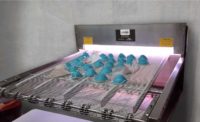A Helping Hand
By Andy Hanacek, executive editor
Suppliers of uniform services and protective apparel have the products, services and expertise to assist processors in meeting sanitation and afety requirements within their plant walls.
To keep the products and employees completely safe and secure within a processing plant takes a certain attention to detail and ability to head off problems and threats before they become an issue. Requirements within the walls of a plant can be numerous, and often, resources do not allow plant managers to focus their efforts continuously on every aspect of prevention that might be required.
Yet, companies that supply uniforms and uniform-management services can help processors knock out threats in one of the key areas through which contamination of product is possible — the employees that walk through the door. Not only are workers and the product protected, but employees in uniforms also develop a vested interest in their work, maintaining high levels of product quality and safety. Often, processors are not fully aware of that benefit of uniform services, says Jan Eudy, corporate quality assurance manager for Cintas Corp.
“The people working on the product can be the source of contamination or the source of control,” she explains. “Many food processors overlook the ‘professionalism’ that is instilled in workers wearing clean, neat uniforms. These workers will take pride in their work and are more inclined to follow policies and procedures as well as instilling a philosophy of teamwork and increasing productivity.”
Protecting product
Providing a certain level of food safety, however, goes beyond clothing employees in uniforms and protective wear. As in any sanitation program, standards must be met. Brenda L. Evans, president of Omni Apparel, Inc., explains that processors cannot cut corners when doing their research and making their final decision on uniforms.
“Food processors often overlook the food safety benefits of buying U.S.A.-made garments,” Evans explains. “All of our garments are made from fabric made here in the U.S.A. and is produced with the knowledge of the chemicals needed to assure the garment is well-sanitized and ready for the worker to wear.
“Any garment that is made and shipped from offshore has a much greater risk of not meeting the U.S. food-safety standards. Purchasing garments from Omni Apparel assures the customer of clean uniforms for food safety.”
For its part, Aramark Uniform Services works to assist processors in integration of its uniform services and food-safety solutions into their overall hazard analysis critical control point (HACCP) programs and Sanitation Standard Operating Procedures (SSOPs), explains Rick Weir, marketing manager for Aramark Uniform Services.
“We’ve implemented our own HACCP program to ensure the consistent delivery of hygienically clean garments,” he says. “The Total HACCP Solution from Aramark Uniform Services provides documented Sanitation Standard Operating Procedures to reduce the risk of cross-contamination from uniforms. Our solution is highlighted in a White Paper written by Dr. Al Baroudi, President of the Food Safety Institute International.”
The White Paper, titled “A Uniform Approach to HACCP,” warns processors to “recognize the risks of improper car, cleaning and garment handling,” and advises that they partner with a uniform supplier that can document all the steps it takes while handling the garments to keep them from being contaminated during transport and cleaning.
For most uniform suppliers, meeting the requirements under HACCP plans is old hat nowadays. These companies have been well-versed in meeting SSOPs and offer processors the ability to protect their products and people without worrying about whether the uniforms will meet specifications. Some companies, such as Cintas, even promote their ability to not simply meet standards, but to enhance the programs that processors have in place, Eudy says.
“Today, most food processors are aware of increasing regulatory compliance and look to Cintas’ services to enhance their existing HACCP program,” Eudy adds. “Many companies already outsource services such as training and payroll, therefore the logical supplier to compliment personnel practices and SSOPs in their prerequisite program is the comprehensive services from Cintas.”
Eudy says Cintas has a comprehensive, in-house HACCP training program for sales, service and production employees to assist food processors with the implementation and execution of Cintas’ services into their HACCP prerequisite program.
“This consulting and partnering approach integrates seamlessly within the food processing industry’s existing risk management programs,” Eudy says.
A uniform supplier’s role in meeting a processor’s HACCP requirements, according to Aramark’s White Paper on the subject, is to manage its operations and abide by specific “SSOPs Critical to Providing Sanitized Garments,” which the White Paper breaks down.
“Uniform features such as snaps instead of buttons, pocket-less lab coats and multiple colors to segment employees by cooked and raw areas are understood as the important benefits of uniforms,” Weir says. “Other important safety benefits can be found in the actual process of laundering the garments and taking the necessary steps to provide hygienically clean garments.
“Some of the SSOPs Aramark has in place include wrapping clean garments in poly-wrap, ATP tests of each batch, keeping soiled garments sealed and away from clean garments, sanitizing our trucks and routine training of our route drivers and plant workers on all of these procedures.”
Protecting people
It’s not just the food that needs to be kept safe and secure, however. Increasing worker safety by use of protective apparel or color-coded uniforms lowers the risk of hazards cropping up on the plant floor, says Scott Carlson, sales manager for U.S.A. and international sales of VR Protective Wear and PolyWear Disposable products for PolyConversions, Inc.
“In providing an effective protective apparel program based on food-safety concerns within a food-processing facility, many processors fail to take into account that they need to establish a ‘cross-protection’ barrier,” he explains, “first protecting the processed food from any potential soil/biological contamination from the employee, and second, protecting the employee from the normal spray and splatter from food-processing activity, including the residual byproducts generated from the processing activity.”
PolyConversions manufactures VR Protective Wear, a cost-effective, more durable and more cleanable replacement for PVC vinyl and other traditional protective, impervious apparel. Carlson explains that switching away from PVC vinyl and other materials that can easily deteriorate and endanger product as well as employees.
“Traditional vinyl apparel is utilized as both a disposable, as well as a limited-use (reusable) barrier product,” Carlson says. “However, when vinyl comes in contact with animal fats and fluids, it has a tendency to stiffen, crack and fleck off loose material. This is caused by the deterioration and the leaching out of plastisizers (one is DEHP, a known carcinogen) used by PVC manufacturers as softening agents in the production of vinyl film.”
This food-safety threat has caused several foreign countries, including Japan, to place embargoes on food and meat products processed in plants using any PVC/vinyl materials with potential direct contact with product, such as personal protective garments.
Processors who want to expand to these markets obviously need to take these things into account. For those processors who want to further strengthen their safety programs through the implementation of uniforms and their associated services, suppliers are definitely prepared to assist them in growing.
Weir believes the future lies in the efforts of those processors with advanced HACCP programs, who have begun to place heavy requirements on suppliers, including uniform suppliers.
“We see a trend in the food industry of expanding HACCP programs beyond the plant floor and out to the supplier community to ensure everything brought into the food production area is not a potential hazard,” he explains. “Forward-looking food processors demand that their suppliers have documented HACCP processes in place to reduce the risk of any contamination.”
While the trends are pointing to tighter focus on suppliers’ programs as well as their products, Carlson says it has been a steady climb thus far in educating processors who have yet to implement comprehensive HACCP plans.
“It is a challenging task to change the mentality and status quo that has been prevalent within this market for many, many years,” he adds. “But we have developed many effective programs within a growing number of major food processors around the country. Our company has been highly successful in educating food-processor management in several major companies of the importance of focusing on food-safety concerns in the proper selection of a protective apparel program.”
Eudy agrees, saying that a comprehensive uniform service provides a more proactive control of both personnel and hygiene practices, a wise strategy to take when attacking food-safety threats.
As the focus on food safety grows in the meat and poultry-processing industries, processors will look to tighten operations and keep product and people more safe. As those processors turn to uniform suppliers for help, Eudy says, the suppliers will be well-prepared to keep processors satisfied with their options.
“Most food processors value the food-safety aspect of a managed uniform program because it prevents problems from occurring and integrates well into their existing HACCP program,” she says.



Report Abusive Comment